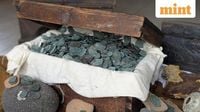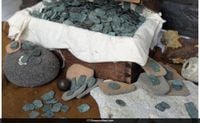Off the shimmering Atlantic coast of Florida, a remarkable chapter in maritime history has resurfaced—quite literally. In July 2025, a team of divers working with 1715 Fleet-Queens Jewels LLC made headlines by recovering more than 1,000 Spanish silver and gold coins from a centuries-old shipwreck, a find valued at approximately $1 million. This latest haul, discovered near Sebastian Inlet along the aptly named Treasure Coast, offers both a tangible connection to the distant past and a fresh spark for Florida’s enduring fascination with sunken riches.
The story begins over three centuries ago, in the summer of 1715. Eleven Spanish ships, weighed down by immense riches—gold, silver, and jewels amassed from the New World—set sail for Spain. Their journey ended in disaster when, on July 31, a powerful hurricane battered the fleet off Florida’s coast. According to Global News and NDTV, the storm sent the ships and their cargo to the ocean floor, spilling an estimated $400 million worth of treasure into the sea and claiming the lives of around 1,000 people. Survivors, battered and bewildered, washed ashore on what is now known as Florida’s Treasure Coast, setting the stage for centuries of adventure, loss, and discovery.
Fast forward to July 2025, and the ocean has yielded yet another bounty. Captain Levin Shavers and his crew aboard the vessel ‘Just Right’ were combing the seabed when they made their extraordinary find: over 1,000 silver reales and five gold escudos, as reported by USA Today and confirmed by multiple outlets. The coins, minted in Spanish colonies such as Mexico, Peru, and Bolivia, were discovered clustered together deep in the sand. Some even bore the telltale pattern of burlap fibers, suggesting they’d once been stored in sacks or chests before the hurricane scattered them across the seafloor.
Sal Guttuso, director of operations for 1715 Fleet-Queens Jewels LLC, told the press, “This discovery is not only about the treasure itself but also the stories it tells.” He added, “Each coin is a piece of history, a tangible link to the people who lived, worked, and sailed during the Golden Age of the Spanish Empire. Finding over 1,000 in a single recovery is extraordinary.” Guttuso emphasized that the real value of these finds goes beyond their monetary worth, highlighting their significance for historians, collectors, and anyone captivated by the drama of the past.
Indeed, many of the coins still bear visible dates and mint marks, making them invaluable for researchers eager to trace their origins. The AP and NDTV reports note that these details help historians piece together the economic and social networks of the Spanish Empire, offering clues about trade, minting practices, and the fateful voyage that ended in tragedy. For collectors, the pristine condition and clear provenance of the coins heighten their allure.
Salvaging such treasures is no simple feat. The operation involved dive crews, a fleet of boats, underwater metal detectors, and even sand suction devices, according to The Express and NBC News. The coins were found in a condensed area, suggesting that the original chest or sack burst open as the ship broke apart. Michael Perna, a fellow salvor, remarked, “This is the largest recovery of coins since 1990. When we find artifacts like this, it reminds us the ocean is still full of surprises after centuries.”
But the journey from seabed to museum display is a meticulous one. Each recovered coin will undergo conservation at Queens Jewels’ laboratory. Using a reverse electrolysis process, conservators will carefully remove marine encrustations and salts, revealing the coins’ original luster. High-resolution photography and detailed cataloguing will follow, documenting mint marks, dates, and origins for both scholarly study and public record.
Florida law plays a significant role in the fate of these artifacts. As outlined by the Associated Press and The Express, the state retains up to 20 percent of recovered finds for research or public display. The remainder is divided among the salvors and their subcontractors. Guttuso explained, “We want to do it right. And it benefits the people of Florida. They end up in the museums.” This arrangement ensures that while private companies bear the risk and cost of salvage operations, the broader public gains access to the most significant pieces, which are destined for display in Florida museums.
The newly recovered coins are just the latest chapter in a saga that has captivated generations of Floridians and treasure hunters worldwide. Over the years, millions of dollars in gold coins from the 1715 Fleet have been discovered along the stretch of coastline from Melbourne to Fort Pierce. Yet, as Guttuso noted, “Every find helps piece together the human story of the 1715 fleet. We are committed to preserving and studying these artifacts so future generations can appreciate their historical significance.”
The recovery also underscores the delicate balance between archaeological preservation and commercial interests. Modern salvage operations in Florida operate under strict state oversight and archaeological guidelines, ensuring that discoveries are documented, conserved, and—most importantly—shared with the public. This approach stands in stark contrast to the lawless treasure hunts of the past, when finds could disappear into private collections with little regard for their historical value.
The excitement generated by this latest discovery has reignited public interest in the Treasure Coast’s maritime heritage. Plans are already underway for select pieces from the haul to be exhibited at local museums, offering Floridians and visitors alike a chance to witness firsthand the glittering legacy of the Spanish empire—and the enduring allure of lost treasure. As the coins are cleaned, catalogued, and prepared for display, they serve as a vivid reminder of the ocean’s power both to destroy and to preserve.
For now, the story of the 1715 Fleet continues to unfold, coin by coin, discovery by discovery. And as the waves lap gently against the Florida shore, who knows what other secrets the sea may yet reveal?





